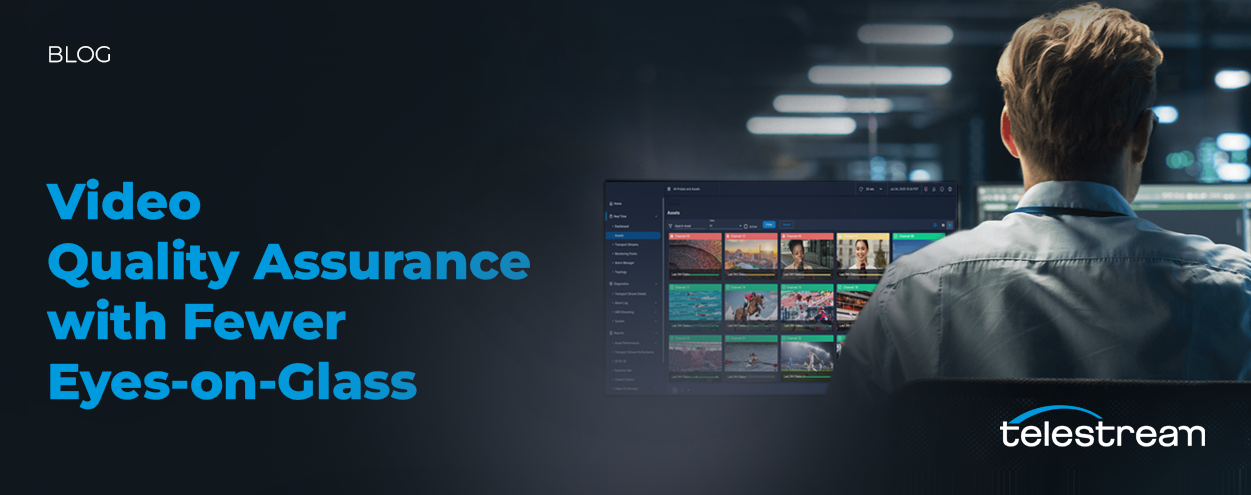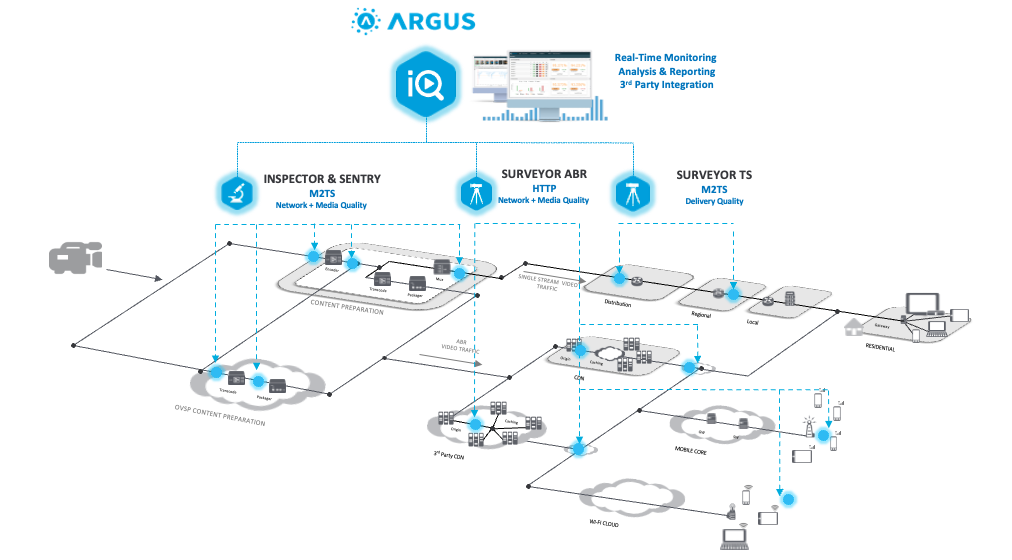By Kenneth Haren
For years, broadcast operations have relied on multiviewers — banks of screens showing real-time video streams — to keep tabs on signal health and content quality. Engineers would sit in front of these displays, scanning for issues with audio, video, captions, or signal dropouts. It was a manual approach built for an era when a broadcaster might have only a handful of feeds to monitor.
Today’s video operations span dozens — even hundreds — of feeds, with each “channel” spawning multiple variants for adaptive bitrate (ABR) delivery with the added complexity of, alternate languages, closed captions, and dynamic ad insertion. Live streaming isn’t just for sports and news anymore. Services like Netflix, Fubo, and Paramount+ are scaling up live content — and that means more live workflows, more failure points, and more pressure on operations teams.
The traditional multiviewer model can’t keep up. It’s too static, too human-dependent, and too limited for a world where video services must operate at cloud scale. What’s needed is a smarter, more scalable approach — one that surfaces issues only when they matter and empowers teams to act decisively.
Why Multiviewers Fall Short in Modern Media Environments
As live streaming expands and video workflows become more distributed, traditional monitoring methods are showing their limits. At best, multiviewers can show that a problem exists — a frozen frame, a black screen, or silence — but they don’t explain why it’s happening or where the issue originates in the workflow. There’s no built-in intelligence to correlate events across the delivery chain, and no way to rewind the clock for post-event analysis. If an issue goes unnoticed in real time, it’s essentially lost with little opportunity to prevent similar issues in the future
For organizations operating at scale — whether streaming live sports, news, or entertainment — the result is inefficiency. Teams are forced to rely on large rooms of screens and overburdened operators trying to manually catch anomalies as they happen – a reactive break/fix methodology. This approach introduces risk, delays troubleshooting, and increases operational overhead. I.
Ultimately, traditional multiviewers are only a partial answer in a landscape that demands intelligent, dynamic monitoring — something designed for scale, automation, and actionable insight.
What Is Monitoring by Exception?
Monitoring by exception is a strategy that shifts the focus from manual observation to intelligent, event-driven oversight. Rather than always watching every feed, operators are alerted only when a deviation from expected behavior occurs — such as audio loss, frame freeze, or bitrate instability. Anomalies are surfaced in real time, allowing teams to investigate and act without the burden of sifting through complex logs and telemetry data.
This approach is transformative for video operations. Instead of staring at walls of screens, operators rely on a system that watches everything — across contribution, encoding, packaging, delivery, and playback — flagging only what matters. This enables smarter, more scalable workflows where resources are focused on resolving real issues, not just monitoring status.
The benefits are immediate and tangible:
- Reduced Operator Fatigue – No more cognitive overload from tracking dozens of clean streams.
- Faster Issue Resolution – Alerts are linked to actionable diagnostics, so teams know exactly where to look.
- Post-Event Visibility – Exceptions are logged and can be analyzed after the fact, supporting trend analysis and root cause investigations.
- Lower Operational Costs – Fewer eyes on glass, more automation, and better use of engineering time.
- Scalability by Design – As channel counts grow, exception-based monitoring scales without adding headcount.
Monitoring by exception doesn’t just optimize workflows — it fundamentally redefines how video quality assurance is approached in high-scale environments while reducing the load on operations personnel.
How ARGUS Delivers Smart Video Quality Monitoring at Scale
The scale and complexity of modern video delivery demands intelligence, automation, and precision. That’s where ARGUS stands out. Designed to monitor every transition point across the video workflow, ARGUS enables detection, diagnosis, and action on quality issues without being buried in noise. At Telestream we hear all the time that an organization has monitoring but no visibility. ARGUS provides the visibility that management, engineering, and operational teams can trust.
ARGUS aggregates telemetry from a nearly unlimited number of Telestream iQ probes — across contribution feeds, encoding chains, packaging workflows, origin servers, and CDNs — bringing it all together in a centralized, intuitive interface. Whether you’re monitoring a handful of high-value live channels or thousands of ABR variants, ARGUS presents a unified view of service health.
Here’s what makes ARGUS uniquely effective for monitoring by exception:
- Centralized observability across geographically distributed workflows, from ingest to playback.
- Live and post-event access, with drilldowns into stream-level analytics and historical performance.
- Root cause correlation across upstream and downstream events — not just alerts, but insights that proactively guide responses.
- On-demand live video playback from within the interface providing ‘eyes-on-glass’ when and where it’s needed and eliminating the need to route traffic through a separate multiviewer or external application.
- Cloud-native scalability, optimized for virtual, containerized, and hybrid environments.
This isn’t just monitoring — it’s intelligent observability. Instead of showing everything, ARGUS shows you what matters, when it matters, with the tools to act quickly and confidently.
Meeting Modern Operational Demands
ARGUS is built for modern video delivery systems with powerful correlation between IPTV and ABR workflows. As streaming platforms scale live content offerings, operational complexity grows exponentially. A single live channel translates to a dozen or more output variants — different bitrates, formats, audio languages, captions, and regional delivery paths. Imagine trying to visualize all this information across multiple multiviewer displays.
ARGUS focuses teams with exception-driven monitoring across the entire workflow. Teams are alerted when something deviates from expected behavior. They can then drill into real-time analytics, historical trends, or even play back the affected stream on demand to assess the issue.
The result is a significant operational advantage: fewer false alarms, faster root cause identification, and better use of engineering resources. ARGUS also simplifies compliance monitoring for ad markers and captions, while providing centralized visibility for teams working across geographies. Whether you’re supporting a handful of marquee live events or running 24/7 linear streaming at scale, ARGUS helps teams stay proactive, efficient, and in control.
Looking Ahead: Smarter Monitoring, Powered by AI
As video operations continue to grow in scale and complexity, the need for intelligent automation becomes even more urgent. Monitoring by exception lays the foundation — but the next evolution lies in applying AI and machine learning to make monitoring not just reactive, but predictive.
At Telestream, we’ve invested heavily in developing perceptual quality models that align with how humans judge video. These AI-driven analytics allow ARGUS to detect impairments that may not immediately trigger alarms but still affect viewer experience. By embedding this intelligence into the monitoring workflow, operators can prioritize the most impactful issues, optimize resource allocation, and ensure consistent service quality — all without increasing operational burden.
The future of monitoring is not more screens or more alerts — it’s smarter systems that filter out the noise and surface what matters most. ARGUS is already helping organizations make that shift today.
Ready to modernize your video monitoring strategy?
Explore how Telestream IQ and ARGUS can help your team monitor smarter, scale efficiently, and stay ahead of quality issues — from contribution to delivery.


